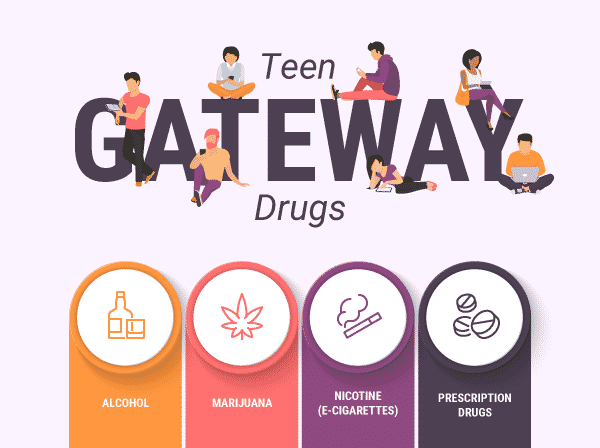Drug use in teens can harm the brain during critical stages of development. Talk to your teen about possible gateway drugs.
Teenagers who use drugscan experience a major impact in their lives. While some degree of drug experimentation is accepted as normal in most cultures, the consequences may be lifelong for some people. The drive to experiment with drugs and alcohol overlaps with the most important time of a person’s mental development. Therefore, parents must be vigilant in paying attention to their teenagers and talking with them about the true risks of drug and alcohol misuse.
By now, many people understand that early programs intended to fight teen drug use were well-meaning but misguided. These include:
- Just Say No
- D.A.R.E
- The War on Drugs
Programs like these built themselves upon theories and ideas about drugs that were not supported by evidence. Since then, we have come a long way in terms of our knowledge about addiction medicine. The American College of Addiction Medicine (ACAAM) was founded only as recently as 2007, meaning that medicine has only had a coherent authority on the topic for less than 15 years. Gateway drugs are a concept that dates back to before the foundation of addiction medication.
What Is the Gateway DrugTheory?
Thegateway drug theorystates that when a teenager is exposed to a legal drug like alcohol, tobacco or marijuana (in some states), the exposure may lead them to use harder drugs or illicit drugs. Other forms of the theory state that someone is more likely to use hard drugs just because they were exposed to a gateway drug.
Treatment Can Be Life Changing. Reach out today.
Whether you are struggling with addiction, mental health or both, our expert team is here to guide you every step of the way. Don’t wait— reach out today to take the first step toward taking control of your life.
The gateway drug theory came because researchers noticed a trend in drug use when they began collecting data. Certain drugs, like alcohol, tobacco and marijuana, were more likely to be used first. Prescription medications and cocaine were likely to be the fourth drug of misuse, methamphetamine and heroin were likely to be the fifth drug tried, and so on.
Several shortcomings of the theory have been identified since it was created. The theory bases itself on drug use patterns of the United States and not other countries. It ignores the availability of drugs — for example, tobacco may be used first because it is legal and easily obtained. It also ignores the fact that people who use illegal drugs might be less willing to admit it.
Researchers have developed a more plausible model to describe drug use in recent years: theCommon Liability of Addictionmodel. The model states that an underlying addictive behavior is the reason for trying new drugs — not gateway drugs themselves.
Why Is the Term “Gateway” Used?
The word “gateway” is a metaphor to help understand the concept. According to the theory, a gateway drug acts like a “gate” into a courtyard of further drug use and more gates.
If we can get teens past the “gates” of alcohol, tobacco and marijuana, then we can prevent the use of hard or illicit drugs in the future.
The History of Gateway Drugs
The gateway theory may have a lot of holes, but research into addiction medicine has come full circle. Researchers published a study in the New England Journal of Medicine that supports parts of the gateway theory but not the classical idea of gateway drugs.
Researchers were able to find a molecular and genetic mechanism which showed that animals had amore addictive response to cocaineafter being given nicotine for several days. The researchers then looked at other studies and found a concerning link between nicotine use and cocaine. Around 75% of cocaine users were smoking nicotine when they tried it for the first time. In addition, people who were smoking when they first tried cocaine were three times more likely to become dependent.
The conclusion here is that some drugs can certainly prime a person to use other drugs, but it does not cause them to. In other words, a “gateway drug” will not cause you to do hard drugs. If you take hard drugs and certain types of gateway drug at the same time, however, you are more likely to become addicted.
Marijuana: The First Gateway Drug
Is marijuana a gateway drug?Marijuana has a reputation as thefirst gateway drug.
This reputation probably springs from social and cultural factors. Marijuana has been illegal but widely used in the United States for quite some time. The only other drugs with usage as widespread in the United States are alcohol and nicotine. Therefore, people can point at marijuana as being the first illegal drug that most people ever try, but this may change if states continue to legalize it.
Common Examples of Gateway Drugs
The substances usually labeled as gateway drugs are alcohol, nicotine and marijuana. However, any drug can be labeled a gateway drug if used duringteenage brain development.
A major risk during teenage years is using a drug in the first place or using more than one drug at a time. Parents should focus on preventing any drug use before adulthood. Teenagers who try drugs are much more likely to develop a substance use disorder (SUD) in the future than those who wait until adulthood.
The following are common examples of gateway drugs:
Alcohol
Alcoholis incredibly harmful to the development ofteenagers. Any alcoholuse is harmful to teens, and preventing that harm is more important than concern over whether it acts as a gateway.
Substances Linked to Teen Alcohol Use
Teen alcohol usemostly happens on its own but is sometimes combined with nicotine.
Marijuana
Marijuanause is increasing in teenagers because of increased access. The legality of marijuana in many states has made it more available.
Substances Linked to Teen Marijuana Use
Marijuana is often combined with alcohol or rolled with tobacco into a “spliff.”
Nicotine (e-Cigarettes)
We know very little about the long term effects of e-cigarettes orteen vaping. However, nicotine is known to be a very addictive substance.
Substances Linked to Teen Nicotine Use
Nicotine ande-cigarettesare very popular on their own, even without mixing with other drugs.
Prescription Drugs
Prescription drugs may include opioid pain medications, benzodiazepines for anxiety and stimulants for ADHD.
Substances Linked to Teen Prescription Drug Use
Painkiller misuse can happen even in teens who receiveopioidsfor a valid reason, such as an injury.Teen prescription drug abusemay happen without any gateway drugs because a prescription is legal.

How to Help Teens Avoid Gateway Drugs
Each parent can take important steps to reduce the risk of their teen developing a drug addiction. As a society, we are beginning to learn from mistakes of programs like “Just Say No.” We cannot just say no — we must speak openly with our teens about their lifestyle choices.
There are a few ways you can help your teen avoid drug use:
- Education: Encourage factual information about drugs. Real stories and factual information are far more compelling than fables of “reefer madness.” Educate your teen about the dangers of using drugs while their brain is still developing. We have strong evidence that this can lead to problems in the future.
- Monitoring teen internet and medication use: Open discussion with your teen is always preferable to surveillance, but careful monitoring can be beneficial as well. Guide your teen to websites with factual sources of information and news.
- Show support: Support the decision-making capacity of your teen. Give them the tools to succeed and trust they will make the right decision.
- Set a good example: Preventing drug misuse starts with you. Demanding a teen to abstain from drugs while you drink alcohol regularly will not work. Model what you are asking of your teen and set a good example, and you can come to an agreement together.
WarningSigns of Drug Use in Teens
Drug use in teens can be hard to spot. Part of normal growth and development during the teenage years is shifting friendships, identities and moods. To identify drug use, one must be able to spot a change that is outside of normal.
Somewarning signs of drug use in teensinclude:
- Being more tired and sad than normal
- Changes in their eating habits
- Having high energy, talking fast or saying things that do not make sense
- Losing interest in their favorite things
- Missing important appointments
- Not taking care of themselves when they used to — for example, not taking showers, changing clothes or brushing their teeth
- Problems at work or school
- Sleeping at strange hours
Help for Teen Addiction
Teen addictionshould be acted on immediately. Teenagers with a drug or alcohol addiction are very likely to develop substance use disorder as an adult.
If you are worried about your teen and think they are suffering from a drug or alcohol addiction, speak with them first. If you both determine that treatment is a good next step, The Recovery Village is here to help.Contact ustoday to speak with a representative who can help determine the appropriate next steps for you and your family.








